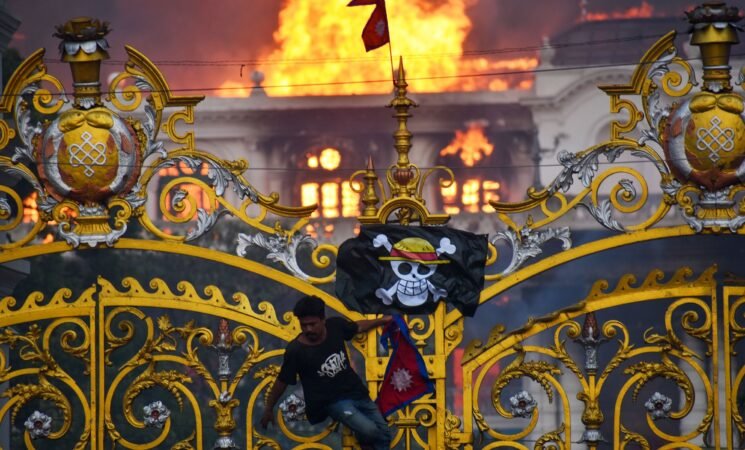3 October 2025, NIICE Commentary 11796
Ritika Suneja
History is testimony to the fact that protests and demonstrations constitute one of the most defining features of democracy, allowing people to express their opinion (through dialogue and discussion), participate in governance, voice collective dissent (as and when required), demand accountability, and influence governmental decisions. It is this very feature of democracy that places the common man at the centre of the government and governance, thereby providing, protecting, and preserving his/her right of freedom of expression, and ultimately serving as a sign of a functional and healthy democratic system that does not treat dissent as a threat or as a rebellion to be suppressed.
To that end, the use of symbols, signs, and flags serves as a powerful and evocative form of collective expression, conveying ideas and beliefs beyond spoken words and lengthy speeches, and uniting masses for a mutual cause that affects their very existence. In that context, the recent protests in Nepal are a glaring example of the above-mentioned proposition. In early September 2025, the country witnessed mass demonstrations largely driven by Nepal’s youth that took to the streets over the cases of rampant corruption, nepotism, and economic hardship that have engulfed the country’s politics. The years of growing dissatisfaction and the erosion of public trust in the governmental institutions, especially among the younger generation, led to an eventual breakdown of state machinery. Ever since the abolition of the monarchy in 2008 and the promulgation of the new constitution in 2015, the leaders taking charge have faced persistent allegations of corruption, leading to an unstable polity in Nepal. The events took an ugly turn when the KP Sharma Oli-led government imposed a blanket ban on 26 social media platforms, including Facebook, X (formerly Twitter), WhatsApp, YouTube, and Instagram, etc. for failing to register with authorities under the new social media regulation directive. The internet has been an open space for expressing discontent with the government, with the citizens also using the #nepobabies hashtag to highlight the extravagant lives that the children of politicians come to live at the cost of those who could not even afford basic commodities.
However, the demonstration that followed, the display of a vivid anime pirate flag, became visible at the forefront of the protests, stating #WakeUpNepal and The Time Is Now. Research says that the use of the anime flag during protests, also known as the GenZ protests, was widely adopted to mark the dissatisfaction and discontent of the youth, portraying it as a powerful symbol of defiance and freedom. Nepal’s Gen Z movement adopted the peculiar Straw Hat Jolly Roger flag from the popular Japanese anime series One Piece, which came into existence in 1997 and has been widely adopted in varied forms ever since. The series revolves around the Straw Hat Pirates as they seek the ultimate treasure and encounter rivals and the authoritarian world government. The flag was flown by this crew. The flag depicting a skull wearing a straw hat with crossbones in its background aims to challenge corrupt powers, a parallel that the protestors adopted in expressing their concern about rising inequality, governance disorders, and lack of employment opportunities. Waving this anime-inspired flag became a visually striking way, as it not only united the youth of the country but also resonated across cultures and instilled ideas that were simple yet prominent.
It is interesting to note how a character that is crafted for purely entertainment purposes ends up playing an integral role in expressing political demands and generating thought-provoking visuals that echo resistance, freedom, revolution, and the urge to fight against unjust governments.
However, the use of anime flags in Nepal is not unprecedented. In fact, protest movements in Indonesia have also adopted the Straw Hat Pirates’ One Piece Jolly Roger flag ahead of the country’s 80th Independence Day in August 2025, as a demonstration of discontent with Prabowo Subianto’s government. Whereas in France, the One Piece flag has made appearances wherein the protestors wore straw hats and carried hand-drawn versions of it and other symbols from the series. The protest has been against President Emmanuel Macron’s government, the political elite, and the planned spending cuts. More recently in the Philippines, the flag was witnessed during an anti-corruption run at the University of the Philippines Diliman in Quezon City that brought to the fore more than a thousand participants.
While the protests did rock different countries at different points of time and space, the use of one cultural symbol made the demonstration inclusive, strengthened solidarity, and communicated ideas unique to every democratic setting, thereby becoming symbols of collective voice and freedom. Herein, three elements, i.e., globalisation, globalisation-induced cultural changes, and international solidarity, play a crucial role. Globalisation has created a world where ideas, media, and cultural icons transcend borders, enabling masses to adopt and internalise ideas and symbols that might not originate in their own societies but still carry universal relevance and imagination. The use of the anime pirate flag in Nepal, Indonesia, France, and the Philippines is proof of this. What began as a fictional character in Japanese culture became a global icon of expression that people across the globe could identify with. This reflects how global interconnectedness enables symbols to transcend their original cultural setting and gain political significance elsewhere.
By embracing elements from popular culture, such as anime characters or ideas from a decentralised platform like the internet, citizens can make their movements more accessible, thereby not only becoming visible but also shaping global political discourse. It transforms protests from being purely political events into cultural expressions of identity, creativity, and rightful defiance, making the message more relatable and notable enough to reach its viewers. At the same time, these cultural references ensure that the protests are not confined to local narratives but resonate with global audiences who recognize the symbols and do not sideline them as a part of “the other culture”. This idea of collective struggle further gives rise to international solidarity that indicates democratic struggles are interconnected and that masses across the world face similar battles, desire the same fundamental rights, indicating how democracy today is sustained not only by local participation but also by a transnational sense of solidarity and shared imagination.
All things considered, while it is undeniably true that the use or instead the incorrect use of the internet can lead to disinformation and perhaps cancel culture at times, but it is movements like these that serve as a symbolic reminder that people everywhere share the same basic human needs and aspirations for freedom, dignity, and justice, and that borders are ultimately man-made divisions. When young protesters in Nepal wave a flag from a Japanese anime, they are not just borrowing from a distinct culture, but are instead blurring the differences of nationality, geography, and social backgrounds, choosing to unite over humankind!
Ritika Suneja is a Research Intern at NIICE and has completed her Master's in Politics and International Relations from Pondicherry University.

